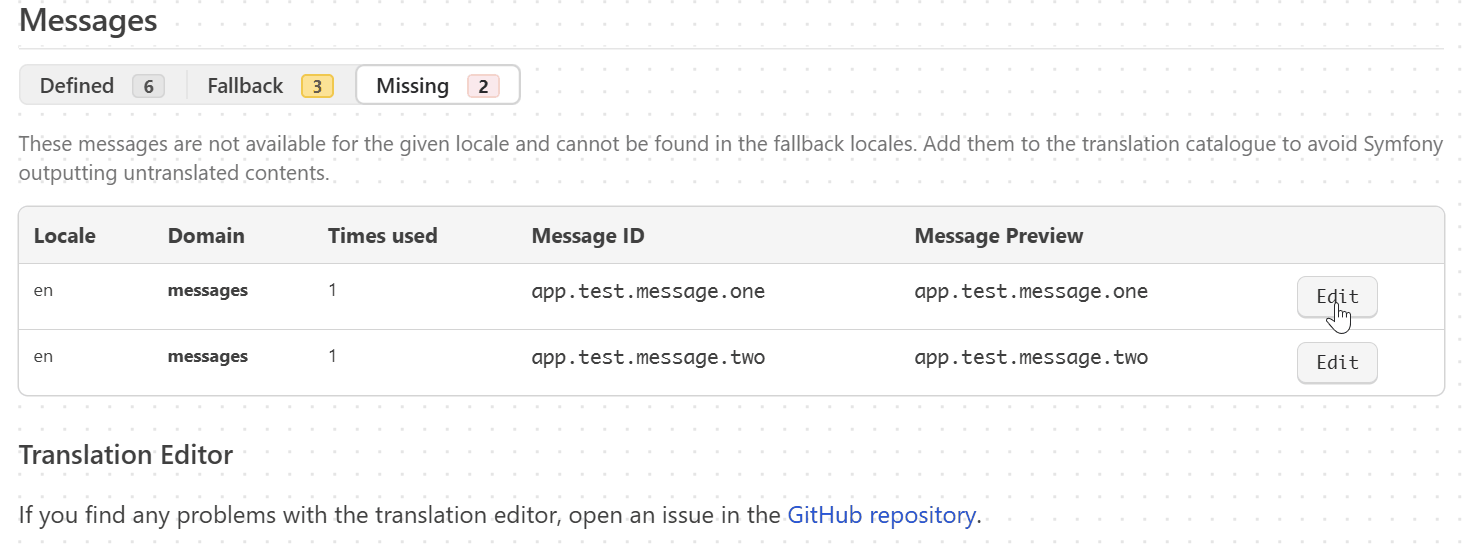jbtronics / translation-editor-bundle
A symfony bundle to allow editing translations in the symfony profiler
Fund package maintenance!
jbtronics
www.paypal.me/do9jhb
Installs: 16 499
Dependents: 0
Suggesters: 0
Security: 0
Stars: 8
Watchers: 2
Forks: 3
Open Issues: 2
Type:symfony-bundle
pkg:composer/jbtronics/translation-editor-bundle
Requires
- php: ^8.1
- ext-json: *
- symfony/deprecation-contracts: ^3.4
- symfony/framework-bundle: ^6.4|^7.0|^8.0
- symfony/translation: ^7.0|^6.4|^8.0
- symfony/translation-contracts: ^2.5|^3.0
- symfony/twig-bundle: ^7.0|^6.4|^8.0
- symfony/web-profiler-bundle: ^7.0|^6.4|^8.0
Requires (Dev)
- ekino/phpstan-banned-code: ^1.0
- phpstan/extension-installer: ^1.3
- phpstan/phpstan: ^1.10
- phpstan/phpstan-strict-rules: ^1.5
- roave/security-advisories: dev-latest
This package is auto-updated.
Last update: 2025-12-15 02:13:26 UTC
README
Profiler Translation Editor Bundle
This bundle provides a way to edit the translations of your Symfony application directly from the Symfony profiler.
This bundle is inspired by the php-translation/symfony-bundle, which offers a similar feature, but has more dependencies and is more complex to use. This bundle provides a simpler and more modern alternative to this, which supports the latest Symfony versions and slightly faster.
Requirements
- PHP 8.1 or higher
- Symfony 6.4 or higher (compatible with Symfony 7)
Installation
You can install this bundle using composer:
composer require --dev jbtronics/translation-editor-bundle
Note the --dev flag, as this bundle is only intended for development and debugging purposes.
If you are using Symfony Flex, the bundle will be automatically enabled. If not, you have to enable it manually in your
config/bundles.php:
return [ // ... Jbtronics\TranslationEditorBundle\JbtronicsTranslationEditorBundle::class => ['dev' => true], ];
Please note that this bundle should only be enabled in the dev environment.
You also need to enable the required routes for your bundle. You can do this by creating a new file in your config/routes
directory (e.g. config/routes/jbtronics_translation_editor.yaml):
# config/routes/jbtronics_translation_editor.yaml when@dev: translation_editor: resource: '@JbtronicsTranslationEditorBundle/config/routes.php'
Configuration
If you do not use the standard paths for your translation files, or not the XLF format, you have to configure the bundle to generate the right files. If you just use the standard paths and XLF format, the defaults should be fine for you, and you can skip this step and you do not need to create a configuration file.
Otherwise create a new file in your config/packages directory (e.g. config/packages/jbtronics_translation_editor.yaml)
and configure the options you need (here the default values are shown):
# config/packages/jbtronics_translation_editor.yaml jbtronics_translation_editor: # The path where the translation files are stored (normally %kernel.project_dir%/translations) translations_path: "%translator.default_path%" # The format in which the translation files should be outputted format: yaml # The version of the XLIFF format to use xliff_version: 2.0 # Any additional options that should be passed to the translation writer. This depends on the format you use. writer_options: #as_tree: true # Use Intl message format use_intl_icu_format: false
Usage
After you have installed and configured the bundle, just open the Symfony profiler for the request you want the translations to edit. In the table with the messages, you will see a new column with an edit button. Click on this button to open a editor for the message and click save to save the changes.
After submission the field is colored blue, while the changes are saved. If the changes were saved sucessfully, the field will turn green for a short time, otherwise red if an error occurred.
Security
The endpoint for the translation editor is not protected. Anybody who can access the web application and the profiler can edit the translations, with all consequences. As translations are not necessarily translated, this could allow attackers to inject malicious code as an XSS attack.
However, this bundle, similar to the Symfony profiler itself, is only intended for development and debugging purposes and should only run in a dedicated development environment, where only trusted users have access (and could modify the code directly anyway). Therefore, the security risk should be minimal in the intended use case.
This bundle enforces the dev environment, so it should not be possible to use it in a production environment. Anyway,
you should make sure that the bundle and especially the translation editor endpoint must not be accessible in a production
environment.
License
SettingsBundle is licensed under the MIT License. This mostly means that you can use this bundle for whatever you want (even use it commercially) as long as you retain the copyright/license information.
See LICENSE for more information.

